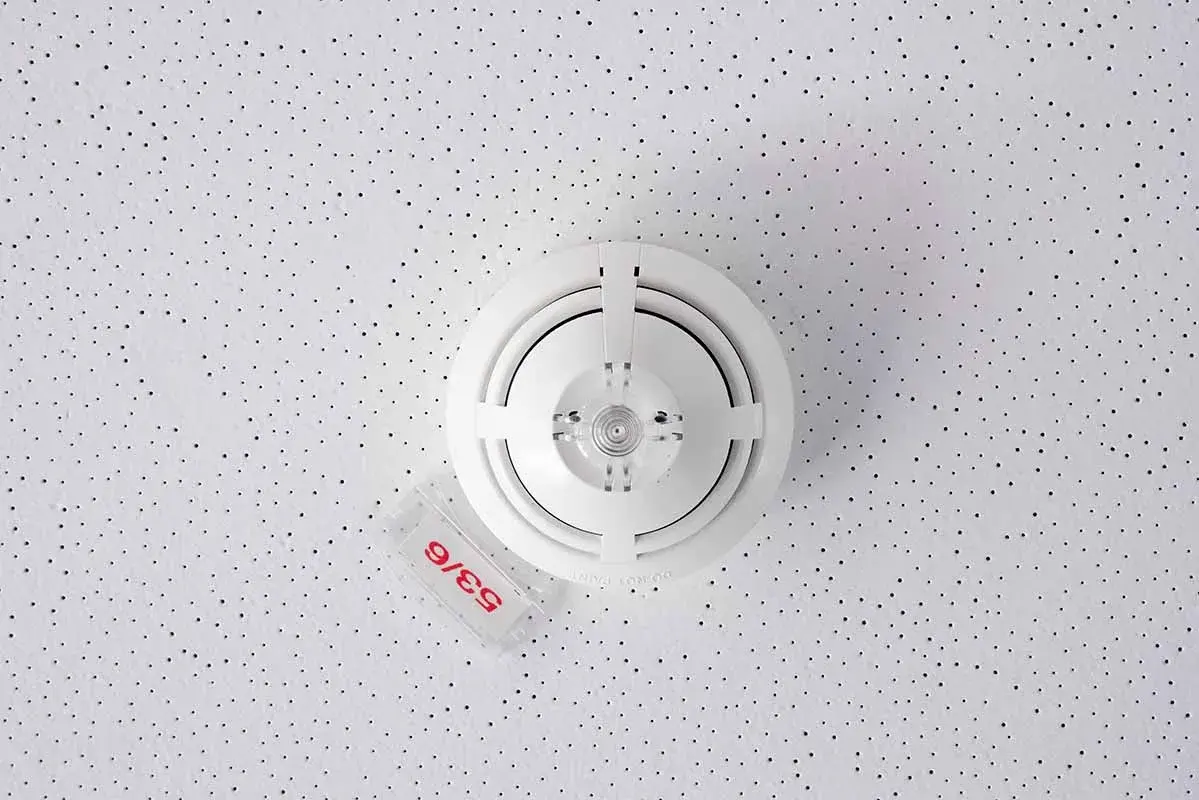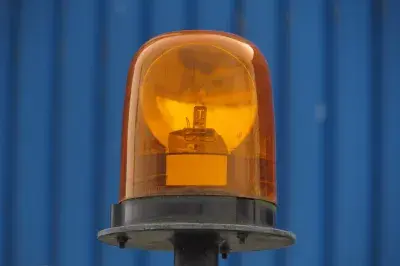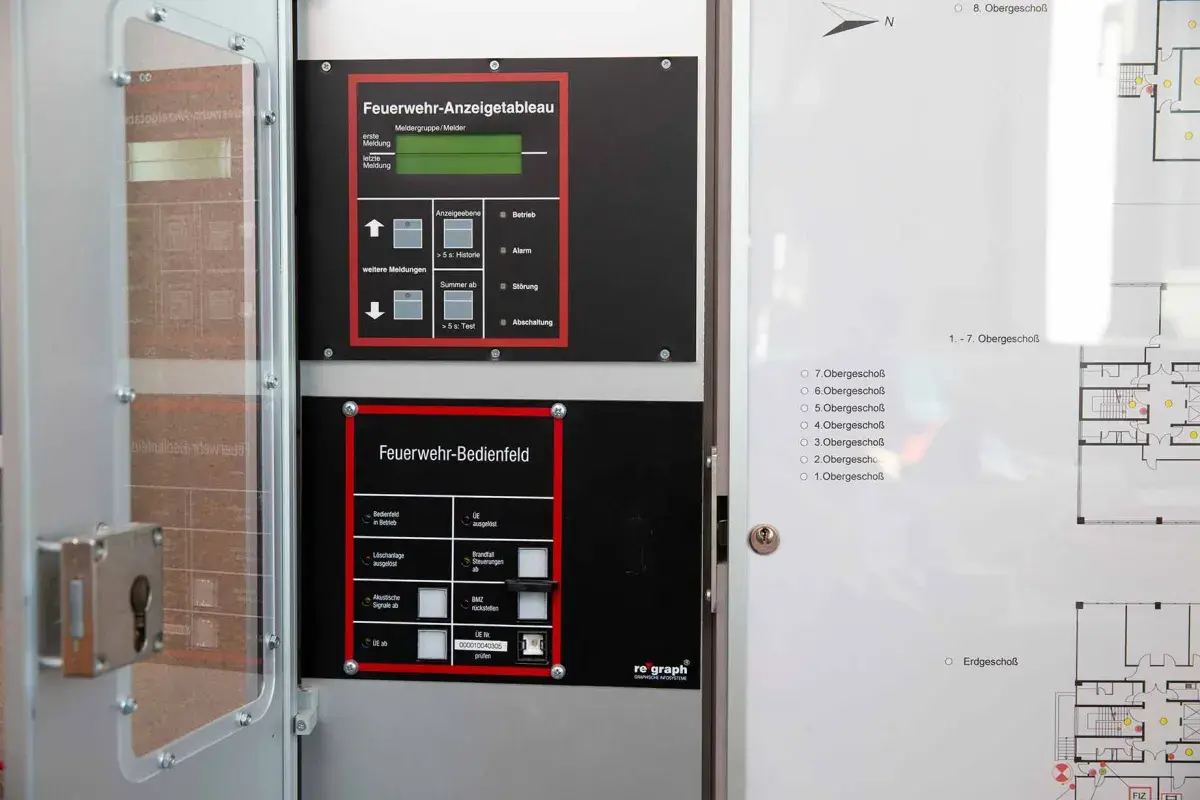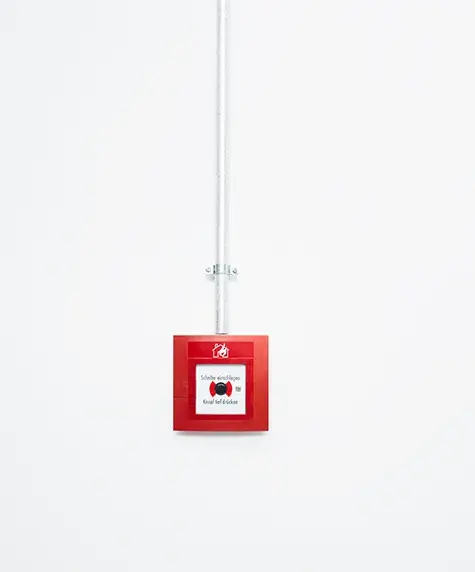A fire alarm system detects fires in the building in the development phase, alarms at an early stage and initiates predefined fire protection measures.
We provide an overview of the structure of a fire alarm system (FAS) according to DIN 14675.
Set-up of a fire alarm system
The structure of a fire alarm system varies depending on the size of the building, official requirements and the requirements of the fire protection concept. The most important components of a fire alarm system are as follows:
- Fire alarm control panel - incl. emergency power supply
- Fire detectors
- Special detectors (e.g. smoke aspiration system or linear heat detectors)
- Signal transmitter
- Fire brigade information centre
The various fire detectors in the building are divided into detector groups so that the danger location can be identified quickly. In addition, other fire protection devices can be triggered in the event of an alarm. These include, for example, smoke and heat extraction systems, escape route controls, ventilation systems and automatic extinguishing systems.

Fire alarm system components in detail
The design of a fire alarm system is specified in DIN 14675 and the VDE guidelines. Consequently, planning, installation and acceptance can only be carried out by certified companies.
CWS is a recognised specialist company for fire alarm systems according to DIN 14675 and VdS.

Fire alarm control panel
The fire alarm control panel (FACP) is the central link in the installation of a fire alarm system. It controls all functions and independently alerts the fire brigade.
It also provides important information for the fire brigade so that a quick and effective fire-fighting operation can be carried out.
Manual fire detector
Manual fire detectors (also called manual fire detectors) are located in the area of escape routes and emergency exits. They report a fire by people breaking the glass and pressing the push-button detector.
In fire alarm systems with direct connection to the fire brigade, red manual call points are used. In the case of house alarm systems (without direct connection to the fire brigade), blue manual call points are used.


Automatic fire detectors
Automatic fire detectors detect various fire parameters such as temperature, smoke particles, UV radiation or carbon monoxide. Depending on the area of application or fire hazard in the building, an individual selection for the installation of a fire detection system is necessary to ensure the best possible fire detection in the early stages.
Important: Detectors must be replaced at regular intervals in accordance with DIN 14675. The intervals vary depending on the requirements for the different detector types.
Signal heads
Signal heads ensure the alerting of persons in the building via sirens or flashing lights. They can be set up conventionally or via the ring bus of the fire alarm system.
In addition, in large public buildings (e.g. in a school or a department store), a voice alarm via ELA systems is possible.


Fire brigade information centre (FIZ)
The fire brigade information centre is an additional component of a fire alarm system. It is used exclusively for the fire brigade. It serves as an additional source of information and shows the fire brigade all relevant information for rapid fire detection and fighting. Thus, the FIZ is obligatory for fire alarm systems with direct connection to the fire brigade.
The fire brigade information centre consists of the following components:
- The fire brigade display panel (FAT) provides the fire brigade with information on alarm messages, operating states and faults.
- The fire brigade control panel (FBF) enables the fire brigade to operate the fire alarm control panel.
- Fire brigade maps are signposts for emergency services to quickly locate the fire site. They show the ground plan of the building and routes. These are also located at the fire information centre.
Fire brigade key depot
The fire brigade key depot is located outside the building and allows the fire brigade non-violent and thus unrestricted access to the building.
Release element
The activation element is to be installed in the immediate vicinity of the fire brigade key depot. It is provided with the lock intended for the respective city and can only be operated by the fire brigade. This should enable the first door of the fire brigade key depot to be opened without violence.

Specialist planner for fire alarm systems
CWS Fire Safety is a certified specialist planner for fire alarm systems.
Our experts have years of experience in setting up a fire alarm system. Thus, we support you in planning, installation, inspection and maintenance. Contact our experts now!
